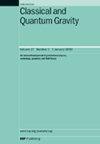LIGO Detector Characterization in the first half of the fourth Observing run
IF 3.6
3区 物理与天体物理
Q2 ASTRONOMY & ASTROPHYSICS
引用次数: 0
Abstract
Progress in gravitational-wave (GW) astronomy depends upon having sensitive detectors with good data quality. Since the end of the Laser Interferometer Gravitational-Wave Observatory-Virgo-KAGRA third Observing run in March 2020, detector-characterization efforts have lead to increased sensitivity of the detectors, swifter validation of GW candidates and improved tools used for data-quality products. In this article, we discuss these efforts in detail and their impact on our ability to detect and study GWs. These include the multiple instrumental investigations that led to reduction in transient noise, along with the work to improve software tools used to examine the detectors data-quality. We end with a brief discussion on the role and requirements of detector characterization as the sensitivity of our detectors further improves in the future Observing runs.第四次观测运行前半部分的LIGO探测器特性
引力波天文学的进步依赖于具有高质量数据的灵敏探测器。自2020年3月激光干涉仪引力波天文台(virgo - kagra)第三次观测运行结束以来,探测器表征工作已经提高了探测器的灵敏度,更快地验证了GW候选者,并改进了用于数据质量产品的工具。在本文中,我们将详细讨论这些努力及其对我们探测和研究gw能力的影响。其中包括多种仪器调查,以减少瞬态噪声,以及改进用于检查探测器数据质量的软件工具。我们最后简要讨论了探测器特性的作用和要求,因为我们的探测器在未来的观测运行中灵敏度进一步提高。
本文章由计算机程序翻译,如有差异,请以英文原文为准。
求助全文
约1分钟内获得全文
求助全文
来源期刊

Classical and Quantum Gravity
物理-天文与天体物理
CiteScore
7.00
自引率
8.60%
发文量
301
审稿时长
2-4 weeks
期刊介绍:
Classical and Quantum Gravity is an established journal for physicists, mathematicians and cosmologists in the fields of gravitation and the theory of spacetime. The journal is now the acknowledged world leader in classical relativity and all areas of quantum gravity.
 求助内容:
求助内容: 应助结果提醒方式:
应助结果提醒方式:


